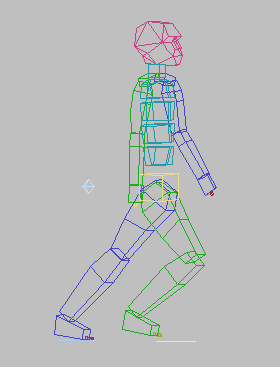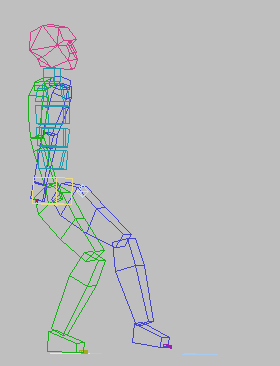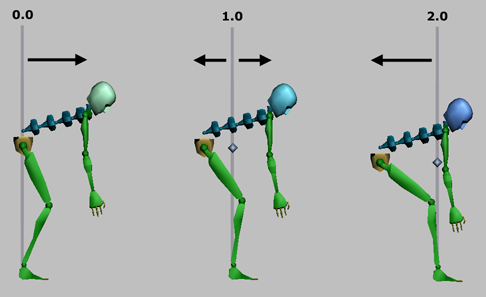After footsteps are activated, you can adjust the biped's overall balance.
There are two ways to adjust the biped’s balance:
- In the Biped rollout, turn on
 (Rubber Band Mode) and move the biped's COM, or
(Rubber Band Mode) and move the biped's COM, or - Change or animate the Balance Factor parameter in the Key Info rollout.
Rubber-Banding the COM
When Rubber Band mode is active, you can move the biped's center of mass in relation to the rest of the body, changing the biped's overall balance. Rubber-banding the center of mass defines your character's balance point in at-rest pose and in any resulting motion.
When a character is standing at rest, with feet side by side, the center of mass should be directly above the area where the feet touch the ground. The center of mass determines the center of your character's distribution of weight. For most characters, the physical center of mass is located near the pelvis.
Typical placements for the center of mass are:
- Characters that stand erect, such as humanoids, use the default location of the center of mass within the pelvis.
- Characters that naturally lean forward, such as some dinosaurs and birds, should have the center of mass moved slightly forward of the pelvis. This is also good for robots and droid soldiers.
- Characters that are holding a heavy weight out in front of them, or overweight characters, might need their center of mass moved slightly forward of the pelvis.
- Characters that are pushing or pulling objects might need their center of mass moved slightly behind the pelvis. Note: If you place the center of mass too far in front of the pelvis, the character unnaturally compensates for balance. As each step is taken, the legs and body move in an awkward fashion, as if there was an invisible weight attached to the front of the character.

Center of mass moved behind the biped in rubber-band mode

Center of mass moved in front of the biped in rubber-band mode
Balance Factor
The balance factor is an animatable parameter that determines how the biped's hips and spine will compensate when the biped bends forward or backward.
The balance factor determines the degree and direction in which the head and/or hips swing out from their original vertical alignments when the biped bends over.

Results when balance factor is set to 0.0, 1.0 and 2.0 before the spine is animated to make the biped bend over.
The Balance Factor parameter can have any value from 0 to 2:
- When Balance Factor is 1 (the default value) and you rotate the spine forward, both the hips and head swing out from their original vertical alignment to a similar degree to compensate for the shift in weight. This value is suitable for times when the biped leans forward while standing.
- When Balance Factor is 0 and you rotate the spine forward, the COM keeps its original vertical alignment, and the head swings forward. There is no movement in the hips to compensate for the shift in body weight. This setting is good for animating a sitting biped who leans forward, to prevent its hips from shifting backward. It can also work well for characters with tails; the tail provides weight in back of the biped, so the hips don't have to shift backward to compensate when the character bends over.
- When Balance Factor is 2 and you rotate the spine forward, the head retains its original vertical alignment while the COM swings backward. The hips compensate strongly for the shift in body weight. This setting can be useful for violent or acrobatic motions.
In order to affect the animation, the balance factor must be set before you animate the biped. The balance factor can be animated to give the biped different reactions to bending motions over the course of the animation.
The Balance Factor parameter appears in the Key Info rollout  Body section.
Body section.
Procedures
To set the balance factor:
- On the
 Motion panel, turn off
Motion panel, turn off  (Footstep Mode) if it is turned on. Note: The Key Info rollout is accessible only when Footstep Mode is turned off.
(Footstep Mode) if it is turned on. Note: The Key Info rollout is accessible only when Footstep Mode is turned off. - Expand the Body bar on the Key Info rollout.
- Go to the frame where you want to set the Balance Factor.
- Click
 (Body Horizontal) to select this track.
(Body Horizontal) to select this track. - If no Body Horizontal key exists at the frame where you want to set the Balance Factor, create one by clicking Key Info rollout

 (Set Key).
(Set Key). - Change the Balance Factor parameter.
There is no need to click Set Key again after setting the Balance Factor parameter.
-
 Rotate the biped's spine.
Rotate the biped's spine. The biped's hips and/or head shift position based on the Balance Factor value.